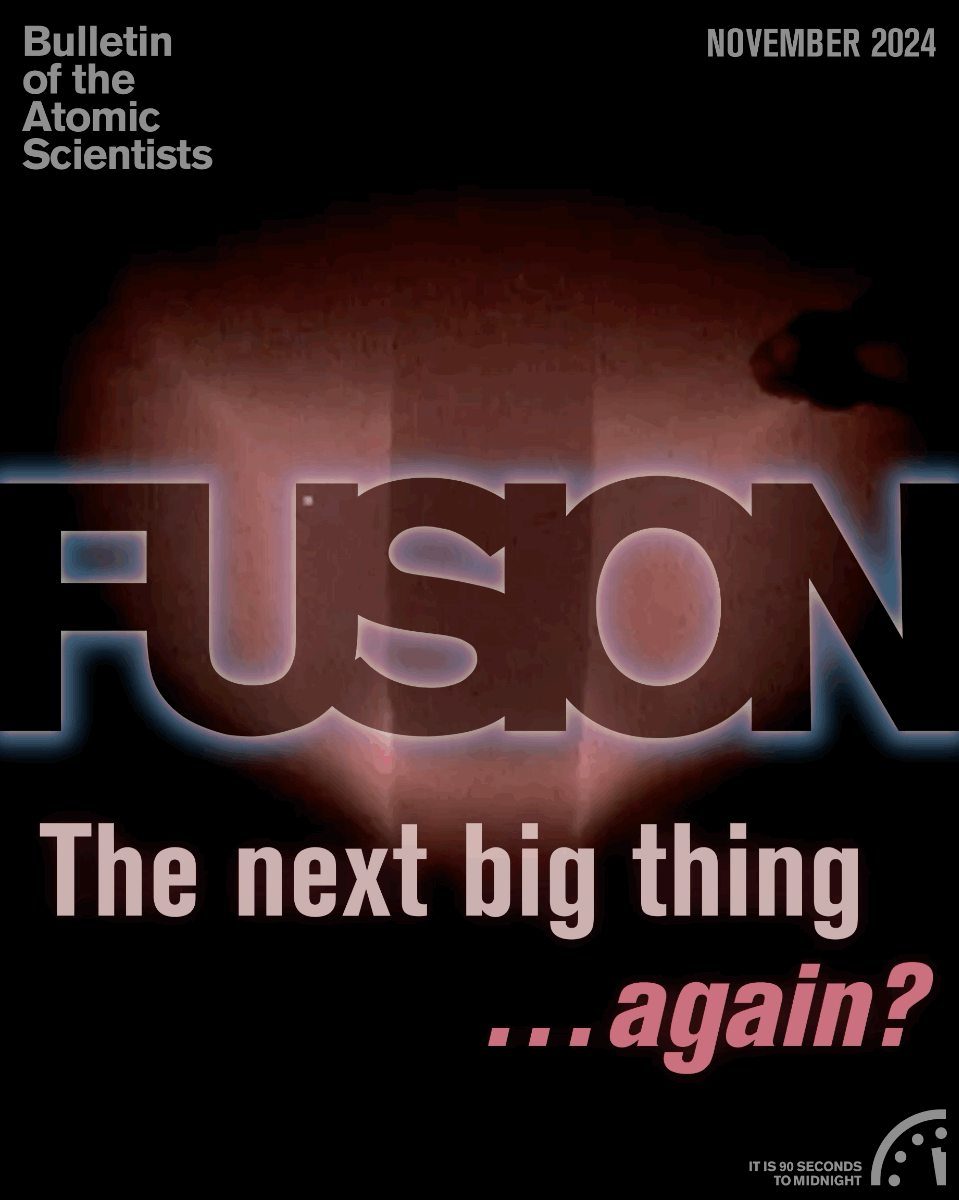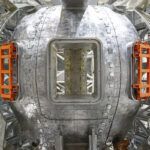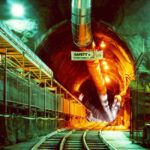Introduction—Fusion, forever the energy of tomorrow?
By Dan Drollette Jr | November 12, 2024
Introduction—Fusion, forever the energy of tomorrow?
By Dan Drollette Jr | November 12, 2024
Nuclear fusion as a source of electricity always seems to be just around the corner. As the old joke goes, “Thirty years ago, fusion was 30 years away from becoming a viable commercial reality”—a comment borne out in the Bulletin’s own pages, if not precisely on a 30-year timescale.
In 1971, physicist Richard Post of what was then the Lawrence Radiation Laboratory published a Bulletin of the Atomic Scientists’ article featuring a chart that showed how fusion—that is, the fusing of hydrogen atoms to release energy, a process that powers all stars, including the Earth’s sun—would be widely available on a commercial scale, routinely pumping electrons to the electrical grid by the year 1990 (although he hedged his bets by labeling it “An Optimist’s Fusion Power Timetable” [emphasis added]).
That optimism was widely shared, judging from the literature in the science and technology press of the time. But it proved to be misplaced: Although militaries have thousands of nuclear warheads based on the fusion process, everything about commercial fusion as an energy source has proven harder and taken longer than expected. For example, more than 60 years passed from the development of the first fusion “tokamak” reactor in the old Soviet Union to the first sustained fusion “burn,” or ignition, at the National Ignition Facility in the United States in 2022.
The difficulties involved in creating a commercial fusion power plant are relatively simple to enumerate, as plasma physicist Bob Rosner—himself the former director of a national laboratory (and former chair of the Bulletin’s Science and Security Board)—explains in his interview, “Ferreting out the truth about fusion.” In a nutshell, the fusion process releases neutrons that are 10 times more energetic than what a commercial plant powered by the splitting of atoms, or nuclear fission, ordinarily emits. These high-powered neutrons are difficult to contain and rapidly degrade the containers proposed for controlling the extremely hot plasma required for a fusion reaction. At the same time, plasmas are just plain difficult to keep stable while producing that all-important steady (or quasi-steady) fusion “burn.” In fact, Rosner notes, it’s likely that if a disruptive instability ever happened at ITER—the giant international research and engineering effort, based in France, that seeks to demonstrate how fusion could be produced in a magnetic fusion device—the multibillion-dollar experimental facility likely would not recover. For these reasons and more, Rosner asserts that commercial-scale, tokamak-style fusion will not be a reality in his lifetime—“and I think not in my children’s lifetime, or my grandchildren’s lifetime.” In addition, he warns about the hype and public relations fluff surrounding overly rosy projections for fusion, or what Rosner terms “a complex mixture of fact, half-truths and outright misinformation.”
It turns out that getting a reliable, steady source of tritium fuel for a fusion reactor would be an extremely difficult problem to crack, as physicist Daniel K. Jassby—formerly of the Princeton Plasma Physics Laboratory—points out. In his article, “The fuel supply quandary of fusion power reactors,” Jassby argues that the fusion reactors now envisioned would not be able to “breed” enough tritium to supply the reactor’s continued operation, and that even a few such reactors (if they ever became reality) would shortly exhaust the world’s supply of that hydrogen isotope, which is not naturally occurring.
So, why would anyone or any institution even go near fusion research? The same reasons keep popping up, in various forms, among the various experts in this issue of the magazine: There’s the desire to know and understand the basic mechanisms of our universe, and the likelihood that fundamental research and development in fusion could lead to big results in other scientific and technological arenas (“self-healing metals” being one of them). And then there’s what fusion research could do for nuclear weapons research in the immediate near-term. As Arjun Makhijani, president of the Institute for Energy and Environmental Research, writes: “Fusion research for peaceful use and military use are highly intertwined, despite attempts to cloak nuclear weapons with the aura of the so-called ‘peaceful atom.’ ”
Given these considerations, it’s understandable that governments continue to back fusion R&D, despite the small likelihood that a commercial fusion power plant will come on-line soon. After all, funding basic research and providing for national defense are core goals for any state.
It is harder to understand why prominent players in the private marketplace—including the founders of Microsoft, OpenAI, Paypal, and Amazon—would invest vast sums on an infant field like commercial fusion. More than $1.8 billion was raised to fund just one startup, Commonwealth Fusion Systems, whose website indicates that it seeks to commercialize fusion energy in some form in just 10 years—decades ahead of government-funded efforts. To help explain their thinking, Silicon Valley venture capitalist and University of California Berkeley professor Mark Coopersmith delves into the world of high-finance. In his interview, “Fusion is not a typical bet,” Coopersmith explains the psychology behind putting down large sums despite long odds—assuming a person already has the money burning a hole in one’s pocket. The prospect of a “super return” of 1,000 or even 10,000 percent makes such “deep-tech” research and development attractive, he says, even if the potential payoff could be decades away.
Similarly, playing the long game may be what is behind China’s recent, large-scale investment in fusion—an investment that goes well over and above that country’s share of its effort in ITER, says Dennis Whyte, former director of MIT’s Plasma Science and Fusion Center, which is collaborating with Commonwealth Fusion to make its tokamak machine. After spending years on China’s advisory and oversight committees on fusion, Whyte gives an insider-ish view on what China is doing to develop what it calls an “artificial sun.” For example, the Chinese government spent about a billion dollars to build and equip a brand-new center called “CRAFT,” which opens next year; the facility is designed to accelerate the development of all the many ancillary technologies needed to get fusion power on the grid and get the base of a supply chain in place for fusion.
In his interview, “After ITER: What China and others are doing in fusion,” Whyte explains why certain advances in technology—such as high-performance computing, machine learning, AI, and huge improvements in magnets and high-temperature superconductors—ultimately make him bullish on the idea that fusion can be a reality someday, in China or any other country.
At the same time, Whyte said he suspects that fusion will still be just in prototype-stage by the year 2035.
Because, Whyte says: “Economic [commercialized] fusion is not a cakewalk; it is not an assured thing at all. Everyone should remember that.”
(For more information about the Bulletin‘s coverage of fusion as an energy source over the years, see our Fusion Energy Archive.)
Together, we make the world safer.
The Bulletin elevates expert voices above the noise. But as an independent nonprofit organization, our operations depend on the support of readers like you. Help us continue to deliver quality journalism that holds leaders accountable. Your support of our work at any level is important. In return, we promise our coverage will be understandable, influential, vigilant, solution-oriented, and fair-minded. Together we can make a difference.
Keywords: NIF, Nuclear Fusion Energy, electricity, energy, fusion research, magnetic confinement, nuclear energy, power, stellarator, tokamak
Topics: Nuclear Energy






















Mentioned above was the following. ”…the first sustained fusion “burn,” or ignition, at the National Ignition Facility in the United States in 2022.” That is a reference to the splashy announcement of the December 5, 2022, laser shot experiment at NIF. It took around a week to prepare the experiment. The fusion reaction lasted for only approximately 0.000,000,000,08 second. The fusion energy released was ~ 3.15 mega joules. The energy, required to pump the lasers was ~ 100 time greater than that needed to compress and heat the plasma. It has been extremely difficult to repeat similar experiments. Approximately 96%… Read more »
I recently wrote about the myth of fusion but this article, as well as mine left out the basic cost problem. Which may be more important than the necessary new science. As for fusion, It is a silly idea only one step above the lizard people conspiracy theories. https://newsblaze.com/ Think of it like this, In 50 years no one has been able to do more than generate a bit of surplus fusion power for a few seconds last spring. Total cost about $1.2T/KW It would take at least 20 years to build one or two experimental fusion power stations, 50… Read more »
Almost every presentation for nuclear fusion energy is a sale pitch for it. Since it is such an arcane and complex field almost all the experts in it are also promoting fans, not independent critical assessors of it. Some provide consulting services for the numerous private funders. The presenter’s pitches tend to employ familiar terms, such as ignition and gain, in ways that are not familiar to most outsiders. Most people assume ignition is something similar to striking a fire-match head. In that case the chemical reaction spreads, from a single point until all the fuel is consumed. With fusion… Read more »
What will we do with all the heat?
Typically the waste heat from electricity generating power plants is dumped into local large bodies of water, or is dumped into the atmosphere, often in the form of humidified air. A substantial portion of the thermal energy generated by such plants ends up as waste heat. Many technically oriented people assume that the survival of the existing technological civilization requires a constant increase in our energy supplies.
I find it astonishing that investors in the DT fusion approaches cannot see the obvious difficulties, some of which are covered above and by Jassby and Rosner. One difficulty that I’ve never seen discussed is the sensitivity of sensors and insulators to the high energy neutrons. About 30 years ago I asked an expert about this; he said they’d hardly last ten minutes in the expected neutron flux. Not what you want to hear when you are using sensors to help control the plasma……
Typically the investors are technical naive regarding this field. They tend to rely upon ‘critical assessments’ created by promoters of this esoteric field since there are almost no critics who are both knowledgeable and also provide consultation services for such investors.
As a total lay person. I understand what happens in fusion is very different to what happens in the nuclear power stations in use today. Therefore, does it carry the same disposal problems as spent rods, half lives, end of life of the power station etc?
This technology doesn’t present the same sort of isolation and disposal problems as fission power spent nuclear (SNF) rods pose. Still, typically half the fuel mix included radioactive tritium which has about a 12.2 year half life and is a short range radiation emitter. That tritium should be contained. It will contaminate the inner walls of the reactor. The fusion neutrons will transmute some of the elements in the reactor structure to radioactive isotopes. Remote handling will be required for servicing the internal chamber. Decomissioning, and inner part replacement will mean components will have to be disposed of as low-level,… Read more »
There is really no hope for Terrestrial Fusion, probably forever, but certainly not in time to save humanity from its continuing burning of fossil energy.
On the other hand, Natural Fussion is already working…and simply needs to have its deployment accelerated.
i present the recess WTIC to make it memorable:
https://uploads.disquscdn.com/images/09597b104b84e91f1e31dae27c07cefbb9984224ce373d4fe4c98b503d0669c9.jpg